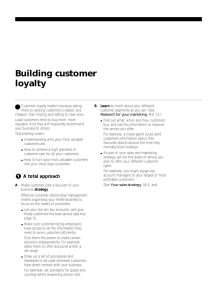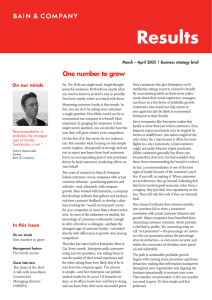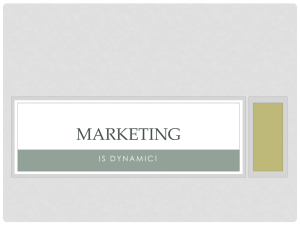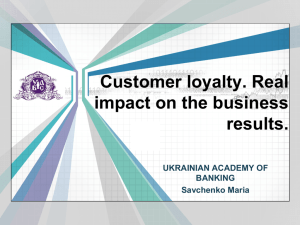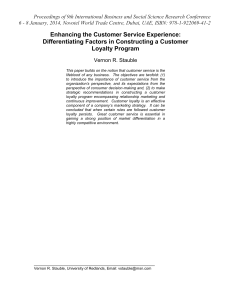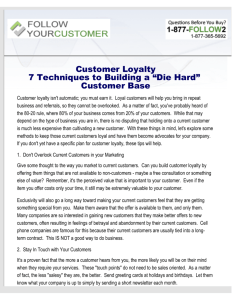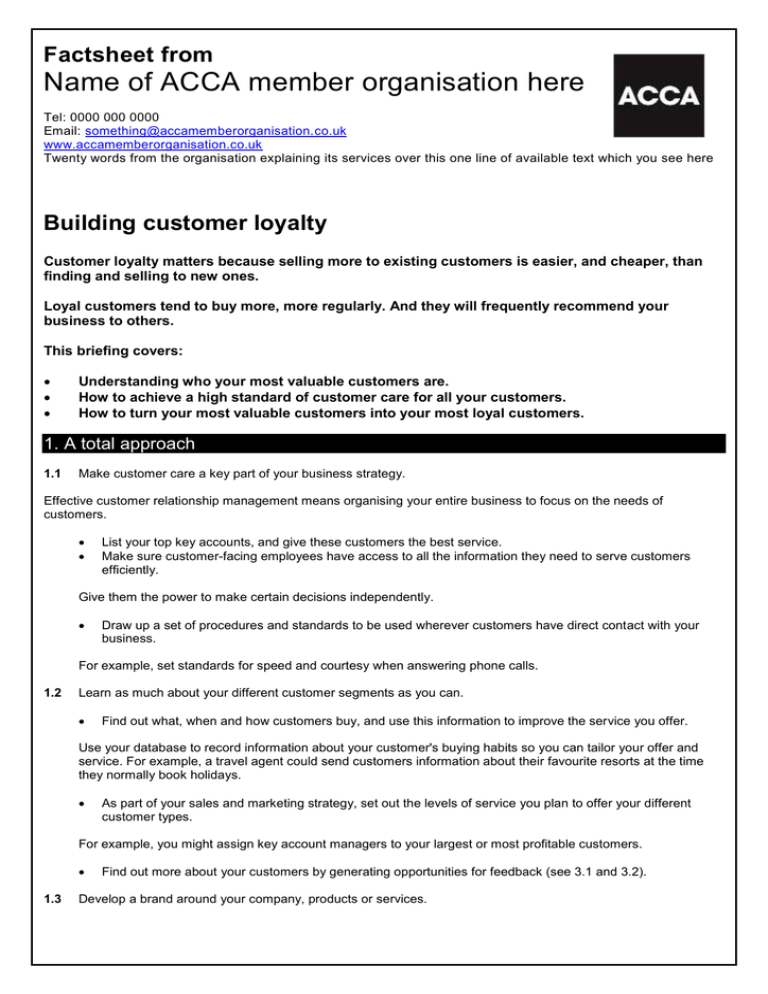
Factsheet from
Name of ACCA member organisation here
Tel: 0000 000 0000
Email: something@accamemberorganisation.co.uk
www.accamemberorganisation.co.uk
Twenty words from the organisation explaining its services over this one line of available text which you see here
Building customer loyalty
Customer loyalty matters because selling more to existing customers is easier, and cheaper, than
finding and selling to new ones.
Loyal customers tend to buy more, more regularly. And they will frequently recommend your
business to others.
This briefing covers:
Understanding who your most valuable customers are.
How to achieve a high standard of customer care for all your customers.
How to turn your most valuable customers into your most loyal customers.
1. A total approach
1.1
Make customer care a key part of your business strategy.
Effective customer relationship management means organising your entire business to focus on the needs of
customers.
List your top key accounts, and give these customers the best service.
Make sure customer-facing employees have access to all the information they need to serve customers
efficiently.
Give them the power to make certain decisions independently.
Draw up a set of procedures and standards to be used wherever customers have direct contact with your
business.
For example, set standards for speed and courtesy when answering phone calls.
1.2
Learn as much about your different customer segments as you can.
Find out what, when and how customers buy, and use this information to improve the service you offer.
Use your database to record information about your customer's buying habits so you can tailor your offer and
service. For example, a travel agent could send customers information about their favourite resorts at the time
they normally book holidays.
As part of your sales and marketing strategy, set out the levels of service you plan to offer your different
customer types.
For example, you might assign key account managers to your largest or most profitable customers.
1.3
Find out more about your customers by generating opportunities for feedback (see 3.1 and 3.2).
Develop a brand around your company, products or services.
If customers can identify with your company and feel good about it, they will be more likely to remain loyal.
Create a consistent, clearly defined identity for your business or product.
Advertise to build brand awareness of your product or service.
However strong your brand is, it should always be accompanied by consistently high levels of customer service.
1.4
Design and deliver a ‘customer experience’ to address how you handle customers when they contact your
business, whether by phone, letter or email.
Do you address customers by their first name or use a more formal form of address?
Follow up queries with a ‘thank you’ letter, email or phone call.
2. Essentials of customer care
Whatever added extras you may offer, they will be useless if you do not give your customers excellent basic service.
2.1
Encourage employees to deliver high-quality customer care.
Make sure employees have good basic communication skills.
For example, a poor telephone manner will ruin the credibility of a telesales company.
Train employees in job-specific skills.
For example, get sales people to listen to the customer more, so they sell intelligently, not aggressively.
Train all relevant personnel how to answer and deal with telephone calls.
Make sure employees can handle complaints effectively.
They should apologise, be sympathetic, listen, establish the facts, agree what to do, and then do it.
Ask employees for ideas on how your customer service could be improved.
2.2
Think of ways to make life easier for customers. For example, a retailer might provide customer car parking, and
a simple procedure for returning unwanted goods.
Concentrate on providing quality service in key areas.
For example, customers often complain that deliveries or maintenance people fail to arrive on time.
Try to save the customer inconvenience. For example, the motor trade gives top priority to maintaining
stocks of ‘vehicle off road’ spares.
Exceed your customers’ expectations. For example, promise delivery in ten days, but actually deliver in
seven. Always keep your promises.
Keep customers informed about any problems, and make it easy for them to contact you. For example, by
providing a freephone number and the direct email address of the member of staff responsible for their
account.
Use your website to give customers the services and information they want.
For example, you could provide a simple ordering system using secure servers, useful information – including
answers to frequently asked questions (FAQs), and technical advice– or a tracking system for orders placed.
2.3
Use appropriate technology.
A good database system can help you record, organise and plan your contact with customers.
2
Make sure information from your website can be transferred to your main database.
Contact management software may be a useful tool if you have a lot of high-value customer accounts.
You will need to explain the advantages of the system to employees, and provide training and incentives for use.
2.4
Give customers a personalised service.
A common way to achieve this is by giving each customer an account manager.
Personalise all communication (see 4).
Personalise the email addresses of customer-facing employees (eg firstname@yourcompany.co.uk).
If you use computerised telephone systems, give customers the option of talking to an operator at any time.
3. Customer feedback
The more you know about customers, the better you can meet their needs.
3.1
Create opportunities for feedback.
Ask new customers why they chose you over the competition, and existing customers what you could do
better.
Set up a customer hotline, and make sure the number is on every piece of communication you send out.
Get feedback online by putting an email response form or forum on your website.
Forums may need filtering or editorial control. Make sure you have time to deal with this before setting it up.
Consider making part of your website registration-only to allow you to get more information about customers.
Encourage customers with a concern to contact you. You may then have a chance to rectify an issue before
it has escalated to a complaint.
Complaints are a vital indicator of what needs to be improved – and how to gain a competitive advantage.
3.2
Contact any customer who has stopped buying from you (a lapsed customer) and find out the reason.
3.3
Carry out customer satisfaction surveys. Keep the questions brief and specific, and offer an incentiveas an
inducement to return the form.
Assign a skilled person to this task, otherwise customers tend to give easy answers, such as “you are too
expensive”, which may hide the real reasons.
Monitor and analyse the contact you have with customers.
Keep a record of customer feedback to help you identify problem areas.
Find out what caused each problem.
Use hit analysis software to discover which of your web pages are most popular.
Call analysis software lets you monitor selling and levels of satisfaction.
4. Communications
If you keep a dialogue going with customers, they will be more likely to buy from you in the future.
4.1
When marketing– or selling – to customers, divide them into at least three groups, and plan a different type of
communication for each.
Group one is potential customers who have not yet purchased anything. For example, someone who has
made an enquiry as a result of an advertisement.
3
The aim of your communication is to build interest in your products. You may also be trying to make a sale at this
early stage.
Group two is customers who have made a purchase.
Your aim is to increase the frequency of their buying and to sell them other products in your range.
Group three is your premium customers, who already make regular purchases.
Your aim is to turn them into ‘advocates’ who recommend you to their contacts.
Your communication is based on showing your appreciation and keeping them informed, rather than selling them
products.
4.2
Only offer products that match customers’ needs.
Ask your customers which of your products they are interested in.
For example, send out a questionnaire.
Regularly email, mail or phone them with special offers, and news about your new products.
Suggest products which will enhance or upgrade what they have already bought.
4.3
Include a checkbox in your written mailings, or on your website, that customers can tick to confirm they want
to receive future communications.
Ideally, you should anticipate when they need to re-order.
Have regular contact with customers. For example:
Telephone key customers regularly to get feedback, or send them a newsletter or e-newsletter.
Send best wishes for Christmas, anniversaries or other occasions.
Be original. The challenge is to distinguish yourself from all other suppliers. For example, you could avoid the
Christmas post by sending an electronic greetings card direct to your customers.
5. Entertainment
One route to achieving customer loyalty is to become friends with your customers. When entertaining customers,
choose events that reflect your company image and set you apart from your competitors.
5.1
For your most important customers, entertain on a one-to-one basis.
5.2
An occasional lunch or an after-work drink can be fitted into most people’s schedules.
Activities like golf provide a relaxed, non-work environment to get to know people in.
Find out what your customer’s interests are, and indulge them.
Check the Bribery Act so that you don’t fall foul of any regulations regarding customer entertaining.
If you need to entertain large numbers of customers, consider having an annual event.
This need not be expensive. For example:
A specialised travel company might put on a video or slide show each year, plus an exhibition of customers’
photos.
An injection moulding company might combine a presentation on state-of-the-art plastics technology (by a
suitably high-profile speaker) with some kind of social networking event afterwards.
6. Added-value schemes
4
A successful loyalty scheme pays for itself by encouraging more frequent purchases. The most common loyalty
schemes are based on offering rewards to loyal customers.
6.1
A cumulative (or ‘retrospective’) discount gives customers money back whenever they reach specified spending
targets.
Retail businesses can offer loyalty cards which work this way.
Your accounting system may need to be able to track the purchasing activity of each customer and flag up
the discounts as they are earned.
If customers have to ask for the discount, you may achieve less loyalty as a result.
6.2
Some schemes offer customers a discount off their next purchase. For example, you may issue discount
coupons. If they are only valid for a limited time, you also encourage prompt action.
Be aware that discounts may cheapen your product in the eyes of the customer.
For this reason, businesses often prefer to make offers such as ‘20 per cent extra free’.
6.3
Some schemes offer the customer rewards.
One danger of discounts and rewards is that your customer might have made the purchases anyway, in which case
you are wasting money.
6.4
Relate your marketing to a specific local or national cause.
Offer to donate part of any money spent with you to support a local cause such as funding for a new community centre.
Give top customers more
Small firms often find that a few big customers are responsible for a large proportion of their profits. Keeping these
customers happy is essential – so you should reserve a special level of service for them.
Give key customers extra benefits which are particularly visible.
A.
Make it easier for them to buy from you.
B.
Let key customers know you value them.
C.
Invite them to special events (see 5), or give them special discounts.
Reinforce the idea that they are valued customers in all communication with them.
Ask for their opinions before making significant decisions.
D.
Waive restrictions such as minimum order quantities.
Give them first options on opportunities such as discounted stock clearances.
Set up a dedicated extranet ordering system.
For example, discuss your ideas for a new product, or a new brochure.
Invite them to join a club.
You could give key customers the opportunity to meet regularly to discuss important issues and enjoy
networking opportunities – broadening the scope and value of what you offer them.
Only make promises you can keep. If you say you will speed up delivery but then dispatch goods late, your special
service will be meaningless.
5
Last reviewed 01.06.11
© BHP Information Solutions 2011. ISSN 1369-1996. All rights reserved. No part of this publication may be reproduced or transmitted without the
written permission of the publisher. This publication is for general guidance only. The publisher, expert contributors and distributor disclaim all liability
for any errors or omissions. Consult your local business support organisation or your professional adviser for help and advice.
6

